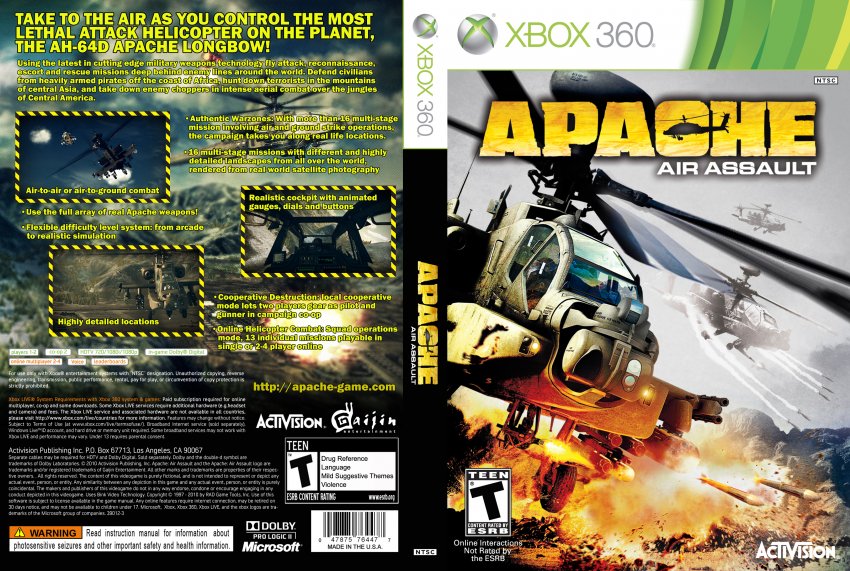

The US Army initially headed in the direction of the vaunted Lockheed AH-56 Cheyenne helicopter to serve their needs but resistance on the part of the US Air Force and political wrangling at the government level killed the project in full in August of 1972, leaving just ten completed prototypes to be shipped to museums. The United States Army recognized a dire need for a new, highly-capable tank-killing helicopter. During this time in history, Germany was still a divided nation split as an East and West region with a multi-national NATO coalition used in managing to keep the peace throughout Europe. Key to the Soviet invasion strategy would have been its large formations of main battle tanks that proved so effective against the mighty German Army in World War 2. As a result, both sides dug in for the long winter ahead by building up arms of every sort. At any rate, the Apache remains a reliable and robust battlefield killing machine that can change the tide of any ground battle upon its arrival - given that the crew be well-trained and well-prepared for the mission at hand.īeyond nuclear attack, the major concern throughout the Cold War became the threat of all-out war on the European continent. Its weapon suite is top-of-the line even by today's advanced technological standards and able to engage multiple armored targets at distance. When used in conjunction with other equipment - such as the Bell Kiowa Warrior armed scout helicopter or Northrop Grumman E-8 "J-STARS" management aircraft - the Apache is something of reckoning force when fielded in numbers against any enemy. Thusly, attack helicopters still form a large part of the success of a modern ground force. Despite the ability for strike aircraft to deliver precision weapons at altitude, modern armies still must rely on the precision nature and hovering capabilities of attack helicopters for strike aircraft operate at high speeds and lack adequate loitering times. As attack helicopters are primarily charged with combat actions at low altitudes close to ground fire and other dangers, it becomes highly susceptible to enemy ground fire and thusly viewed as more "fragile" when compared to high-altitude, high-speed fixed-wing aircraft mounts.
#APACHE AIR ASSAULT 2004 SERIES#
The two-seat Bell AH-1 Cobra dedicated attack helicopter series debuted during the latter stages of the war and further drove home the point through use of rocket pods, triple-barrel cannon, automatic grenade launcher and guided TOW missiles. The Vietnam War proved this for the US Army, where transport helicopters were being armed with rockets, cannons, grenade launchers and machine guns and successfully affecting battle outcomes when called. Today, the AH-64 Apache is formally branded under the Boeing Defense, Space & Security name - or Boeing for short.ĭespite the changing face of the modern battlefield, the attack helicopter has proven time and again to be a critical component to any land-based action.

In turn, McDonnell Douglas was merged with The Boeing Company in 1997 to become a subsidiary. In 1981, Howard Hughes created Hughes Helicopters, Incorporated and, while the AH-64 Apache began life under the "Hughes Helicopters" brand label, the company ultimately became a subsidiary of aviation giant McDonnell Douglas in 1984 and therefore known as McDonnell Douglas Helicopter Systems.

Summa Corporation was started by Howard Hughes after the sale of his Hughes Tool Company that same year (the tool company itself would eventually emerge as "Baker Hughes"). Hughes Helicopters then came under the Hughes Tool Company in 1955 and was formed into Hughes Helicopter Division as part of the Summa Corporation in 1972. Hughes Helicopters began operations in 1947 as part of the Hughes Aircraft firm - owned by legendary businessman and aviator Howard Hughes. Over 2,000 Apache attack helicopters have been produced and it is expected that modernization efforts will keep the Apache a viable battlefield implement up through 2020. The Apache family line has amassed over 3 million hours of flight time since its first prototype flight and production of new airframes is still ongoing as of this writing. The Apache is a proven war-winner, having displayed her tank-killing prowess in the Persian Gulf War against the once-formidable armored formations of Saddam Hussein. She went on to see extensive combat actions throughout the 1980s and 1990s across conflicts such as Panama (Operation Just Cause), the Persian Gulf War (Operation Desert Storm) and the Kosovo War as well as more recently being tied to operations in Afghanistan and Iraq. The Hughes / McDonnell Douglas / Boeing AH-64 Apache has served American and allied military forces well during her storied operational tenure which officially began in 1986.


 0 kommentar(er)
0 kommentar(er)
